Capital ships laid down after 1902
Catalogue number 71091
The last foreign-built battleships, Kashima and Katori
The two Kashima class battleships were laid down in 1904 at Armstrong's (Kashima) and Vickers (Katori). From then on and apart from the battlecruiser Kongo (see below), Japan built her own battleships although initially, they used much imported materials and equipment. They were to an improved design (heavier secondary armament of 10-inch guns, more 6-inch guns) of the King Edward VII class carrying a main armament of two twin 12-inch guns fore and after.
Credit: Marius Bar
13.3cm x 8cm Gelatin silver print
|
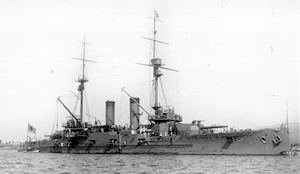 |
Catalogue number 38035
Launching of Katori, 1905
Chains fly as wood floats away and the cradles race down the slipway into the sea at Barrow-in-Furness.
Verso: "Launching of the battleship "Katori" of the Japanese Navy 17000 HP 20 Niclausse boilers" in French and in heavy pencil
27.1cm x 20.6cm Silver print of a printed image
|
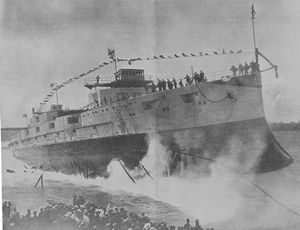 |
Catalogue number 102084
Launching of Katori
Katori was launched by Princess Arisugawa in the presence of her husband, cousin to the Japanese Emperor. He had made his career as an officer in the Imperial Japanese Navy. S.S. Keemun was a Blue Line passenger and cargo ship operating, at some time, between the Pacific coast and Asia. Dodwell Ltd. was a London-based shipping agent but had its origins in China and Japan in the mid-19th century. The company, agent for the S.S. Keemun, had a branch in Tacoma to where this postcard was addressed. So we can see a link between the launching of this warship in Britain, Japan and the postcard to Mr Scott on a Dodwell-agent ship. Note the ram bow and the traditional garland hanging from the bow.
Recto: "Japanese Warship "Katori" Launched at Barrow. July 4 1905" in black ink
Verso: Postcard adressed to "Mr John Scott, 2nd. Engineer S.S. "Keemun" c/o Dodwell Ltd. Tacoma U.S.A." in black ink
9.5cm x 7.1cm Gelatin silver print
|
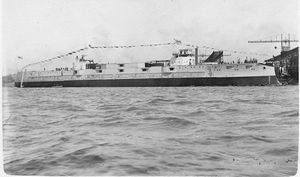 |
Catalogue number 95040
Katori at the Vickers fitting-out bassin, 1906
The hammerhead crane at Vickers fitting-out bassin dominates the Japanese battleship at Vickers shipyard. Katori has yet to receive her main armament.
Recto: "10-2-06 The two ships at present under construction here. To the left the Japanese battleship "Katori" under the crane. To the right the English (sic) cruiser "Natal" with its guns. Best regards" in French and in black ink. "HIJMS Katori HMS Natal" in white letters
Verso: Postcard franked Barrow-in-Furness 10th February 1906 and sent to an address in Paris
8.8 cm 14cm Gelatin silver print
|
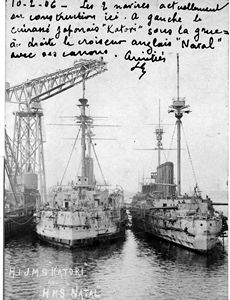 |
Catalogue number 123024
Katori under tow at Birkenhead, 1906
This photograph shows the completed Katori under tow at Birkenhead for hull cleaning in anticipation of sea trials on the Clyde. On leaving Barrow the ship arrived off Woodside Landing Stage in Birkenhead on 12th April under tow from the steam tug Blazer.
Verso: Postcard franked "Rock Ferry Birkenhead 14th April 1906" and sent to "Madame Isaac Roberts, Chateau Rosa Bonheur" with the text "With kind wishes and Easter greetings from Phalib (?). Madame Roberts, born Dorothea Klumpe, was one of five sisters who inherited from the artist Rosa Bonheur. She was a renown astronomer and married Isaac Roberts in 1901.
13.8cm x 9.1cm Gelatin silver print
|
 |
Catalogue number 17033
Katori underway in British waters
In this view, we can see the two starboard single 10-inch gun turrets of the secondary armament. The 6-inch guns do not seem to be mounted yet.
Verso: "Post card British Made"
13.3cm x 8.3cm Gelatin silver print
|
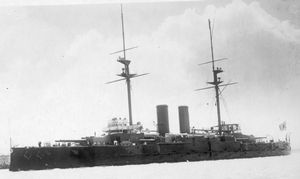 |
Catalogue number 104052
Battlecruiser Kongo
Kongo was designed and constructed in the Vickers shipyard (laid down 1911 and completed 1913) and was truely the last Japanese capital ship built by a foreign shipyard although much material for three Japanese-built Kongo class came from Vickers (e.g. 31% for Haruna). She was one of four Kongo class battlecruisers armed with 14-inch guns. All four ships were extensively rebuilt in the 1930s. Kongo is not showing any flag so maybe this photograph was taken during speed trials.
12.9cm x 7.8cm Gelatin silver print
|
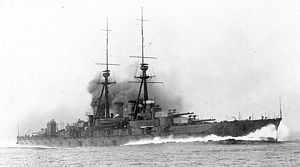 |
Catalogue number 80193
Battleships from the main Navy yards, Aki
Laid down in Japan but 50% of the material came from abroad, for example Aki was fitted with Curtis turbines from the Fore River Yard in the U.S.A.
Credit: Possibly from Jane's Fighting Ships
10.8cm x 6.2cm Photo negative of printed image
|
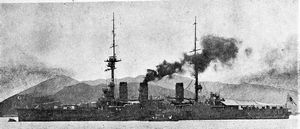 |
Catalogue number 80194
Settsu and Kawachi, an improved Aki design
Settsu, laid down 1909 and completed 1912, was one of two heavily-gunned battleships from the Kure and Yokosuka naval yards. They carried four 12-inch, 50 calibre guns in twin turrets fore and aft as well as eight 12-inch, 45 calibre guns in twin turrets port and starboard. Note the clipper bow.
Credit: Possibly from Jane's Fighting Ships
11.3 x 7.6cm Photo negative of printed image
|
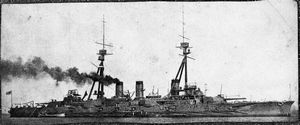 |
Catalogue number 80196
The heavily-armed Kawachi, twelve 12-inch guns
Built in naval shipyards, these two ships had Brown-Curtis turbines of American design constructed under licence by Kawasaki and only about 20% of material came from abroad. The idea behind the reduced calibre broadside 12-inch guns was to reduce blast and enable them to be positioned closer together. In practice, these guns had a reduced range and blast was still a problem.
Credit: Possibly from Jane's Fighting Ships
9.3 x 5.8cm Photo negative of printed image
|
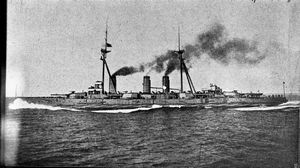 |
Catalogue number 30048
Nagato as completed in 1920
After the Settsu class battleships, the Japanese battleship design adopted superimposed main armament (Fuso and Ise classes). The two Nagato class ships were laid down in 1917 (Nagato) and 1918 (Mutsu). They continued this design and introduced the heavy, six-legged foremast with a central column, said to give better stability for the various directors, lookout platforms and searchlights as well as resisting battle damage.
Verso: "Not to be scrapped. The latest Japanese battleship the "Nagato" just completed which the Japanese Navy Authorities have obtained permission from the Washington Conference to retain."
20.2cm x 15.2cm Gelatin silver print
|
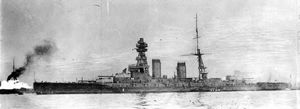 |
Catalogue number 80195
Mutsu, pre-1923
Mutsu and Nagata were, along with U.S.S. Maryland, the first battleships to mount 16-inch guns. Note the heptapodal foremast with its central column, during reconstruction in 1936 numerous platforms were added to give the characteristic "pagoda" look.
Credit: Possibly from Jane's Fighting Ships
10.6cm x 6.4cm Photo negative of printed image
|
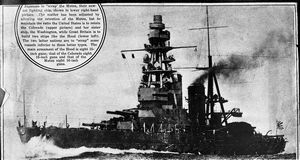 |
Catalogue number
Nagato or Mutsu pre-1921-1923.
This photograph is prior to the installation of a smokehood on the forefunnel (Nagato 1921 and Mutsu 1923) in an attempt to solve the problem of smoke and heat on the occupants of the foremast posts. Note the unusual opening in the hull at the stern. There was a certain irony in the Allies demand for Japan to scrap the newly-built Nagato and Mutsu at the Washington Conference when the U.S.A. was building ships of the same calibre. Such an attitude participated in the souring of Anglo-American Japanese relations during the inter-war years.
5cm x 4cm Gelatin silver print
|
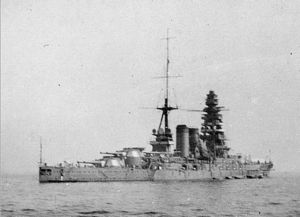 |
Catalogue number 44258
Battleship Kaga completed as an aircraft carrier
Work on the battleship Kaga stopped in 1922 in accordance with the Washington Treaty but construction as a carrier took up again in 1925. This photograph shows the carrier at an intermediate stage during the 1934-1935 reconstruction. The trunked boiler uptakes running back to the stern have been replaced by a single downward curving funnel to starboard. However, the hangers and flight deck have not yet been extended forward.
Verso: "Aircraft carrier Kaga, Japan" in light pencil
12.6cm x 8cm Gelatin silver print
|
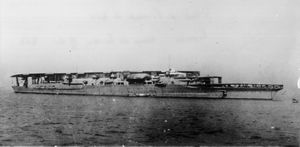 |
Catalogue number 61034
Tsukuba class battlecruisers
With a view to conducting warfare on commercial shipping, Japan built a number of fast and well-armed battlecruisers. The two Tsukuba class mounted four 12-inch guns in twin turrets fore and aft with a broadside of twelve 6-inch guns, they could reach 20.5 kts. In this photograph, the 12-inch guns seem almost too big for the hull. There is a steam pinnace alongside.
Verso: "Japanese" in French and in light pencil
Credit: Bougault
27.3cm x 9.6cm Gelatin silver print
|
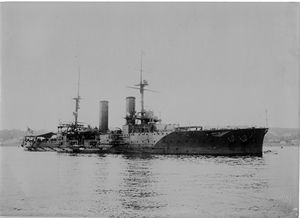 |
Catalogue number 17006
Washing day on Tsukuba
Hammocks and clothes are hung out to dry and yet the Japan flags are still flying. Once again, a smart steam pinnace is alongside.
Verso: "Tsukuba" in light pencil
15.2cm x 7.6cm Gelatin silver print
|
 |
Catalogue number 17006 detail
Steam pinnace from Tsukuba
Although built in the Kure Naval Yard, Japan, it is a very "Royal Navy" type of pinnace that is moored to the boom.
15.2cm x 7.6cm Gelatin silver print
|
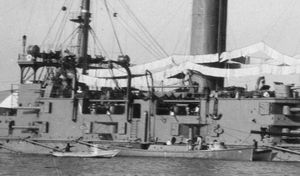 |
Catalogue number 92108
Tsukuba in the Mediterranean Sea
Construction of Tsukuba and her sister ship Ikoma were hampered by the lack of steel plate and rivets available in Japan and the builders had to import part of this material from the U.S.A. On completion in 1907, Tsukuba went to the U.S.A. and then visited several ports in Europe, here she is shown at anchor off the coast in the south of France. This ship was lost in a tragic magazine explosion (305 killed) in 1917. The cause of the explosion is unknown but was probably due to spontaneous ignition of cordite, the cause of the loss of several warships during the Great War including the Japanese battleship Kawachi (1918).
Credit: Bougault
13.5cm x 8.4cm Gelatin silver print
|
 |
Catalogue number 80189
Ikoma
This photograph of a broadside view of the battlecruiser Okoma has been retouched to remove the washing hung out from the foremast. The 12-inch guns look impressive but this didn't stop Ikoma being broken up in 1924 in accordance with the Washington Treaty.
Verso: "31 July 1910 Dimanche Illustré" (editor's note: a weekly supplement to the newspaper Excelsior from 1923 to 1944)
10.7cm x 5cm Photo negative of printed image
|
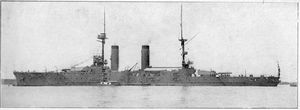 |
Other warships laid down after 1902
Catalogue number 80409
Kuma class Light Cruiser Kitakami, Shanghai 1937
Kitakami was laid down in 1919 and had a long career, she is shown here in 1937 during the Shanghai incident. The 5.5-inch guns are ranged broadside ready for action and the Japanese crew are very interested in the French warship from which this photograph was taken. Note the improvised bullet and splinter protection as well as the profusion of voice tubes running from the bridge up the foremast and to aft.
Recto: "102. Bridge of "Kitakami" 25/4/37" in white text and in French
| | |